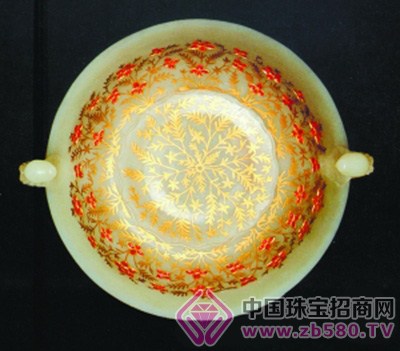
Clear imitation
As the Emperor Qianlong settled the Tianshan Mountains to the north and south, and returned to Xinjiang, a large number of jade articles from Central Asia and West Asia began to use Xinjiang as a corridor and eastward into the Middle Kingdom. These extra-territorial jade crafts are strange and exudes a strong exotic atmosphere. After flowing into the Qing Dynasty, they were deeply loved by the Emperor Qianlong. After their personal research, they were named "Study of Jade."
According to the Qing Dynasty "Tea Guest Words" and other books, "Mark Dustan" is the Mughal Empire, and today's northern India, Kashmir, Pakistan and eastern Afghanistan, "good jade", all over the country. However, according to modern scholars, the "Study of the Stan Jade" hidden in the Qing Palace, in addition to the Mughal Empire, and the jade articles produced by the Ottoman Empire in Turkey, the source is not single, but it is common in Central Asia and West Asia. Faith in Islam, the materials, crafts, instruments, shapes and decorations of jade articles have more similarities.
The jade material selected by the "Stone Dusit Jade" is the same as the jade in the mainland. It is mainly based on Xinjiang Hetian jade, but likes pure solid jade material, one color and one color, especially the white and jade, jasper and sapphire with calm and restrained color. I like to use the pretty colors to form a sharp contrast. Its utensils are closely related to the daily life of the Islamic region. The main types are bowls, plates, cups, spoons and other food utensils, pots, bottles, cans, boxes and other storage devices, as well as stationery, short sword handles, etc. Miscellaneous utensils are practical, and there are no decorative jade, etiquette jade and funeral jade that are often found in the interior.
The shape of the traces of the Stan jade is often designed in the form of flowers or animals, and the chrysanthemum discs, leaf cups, and sheep's head cups are extremely common. The ornamentation of the utensils also includes plant patterns such as lotus, sunflower and banana leaves. In addition to the complicated techniques such as embossing, round carving and hollow carving, the decorative method often embeds gold, silver filament and red, green, yellow and blue glass, gemstone or jade in the outer wall of the object to form the visual contrast of the concave and convex. Colorful and colorful.
The most praiseworthy of the Stan Jade is undoubtedly its exquisitely thin carcass, most of which can see the pattern and decoration of the outer wall from the inner wall. This superb water-slurry tire technique was praised by the Emperor Qianlong for a long time: "Xi Kun jade is very skillful, water-grinding jade is as thin as paper", "it is suspected of being in the hands, and the eyes are fixed and tangible", "fine as a hair, no "Axe chisel marks", even Ji Xiaolan also said in the "Notes on Reading the Weed Cottage": "The jade of today's jade is the first with the trace of Stan."
Out of love, Qianlong instructed the Qing Dynasty Office to try to imitate the traces of the Stan jade, and the influence was also affected. Suzhou’s alleys and other places were also copied, but because of the differences in religious beliefs and cultural backgrounds, and the differences in craft traditions, Although the shape of the utensils is similar, it can only be shaped and difficult to ask for.
Sports Blazer,Blazer Shirt,Long Blazer Jacket,Leather Blazer Men
SHAOXING RUIZI IMPORT&EXPORT CO.,LTD , https://www.ruizigarment.com